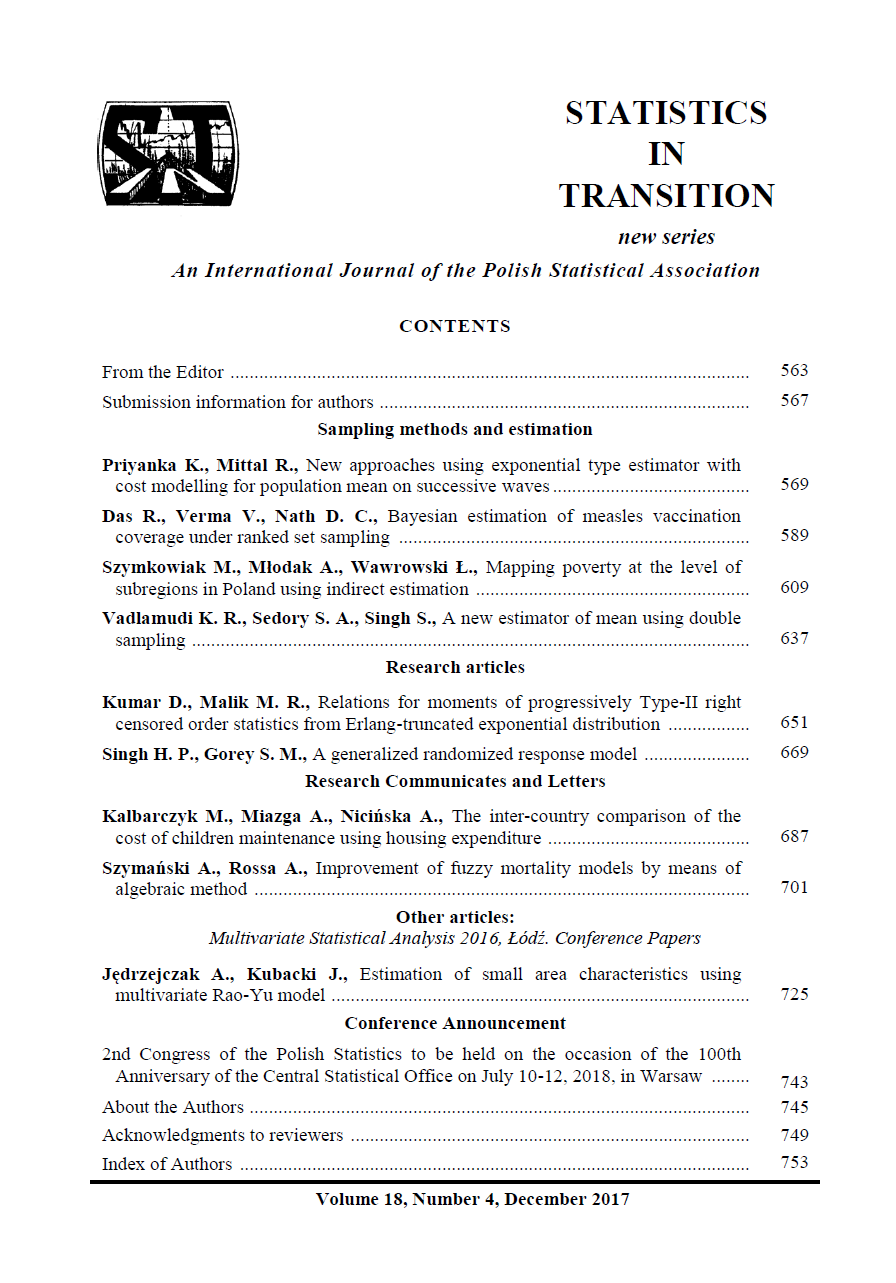ARTICLE
ABSTRACT
It is interesting to compare maintenance costs of children between countries with similar yet different family policy regimes because this could yield valuable lessons for researchers and policy-makers and also for the sake of methodological development. In this study, we aim to conduct a comparative analysis of the equivalence scales in Austria, Italy, Poland and France taking into account the age of children. To this end, we use data from the European Income and Living Condition (EU-SILC) to calculate equivalence scales for mono- and duo-parental households for the first and second child. The four countries share common European cultural context, yet differ with respect to social environment, in particular to family policy. We apply the Engel estimation method proposing the share of housing spending in total expenditures as a tool to obtain commodity-specific equivalence scales. Our results are consistent with other studies showing that the cost of a first child is higher than that of a later child. The scale values are not the same across all the countries concerned, with the highest cost observed in Italy and the lowest in Poland.
KEYWORDS
equivalence scales, EU-SILC, housing expenses, Engel curves
REFERENCES
BALLI, F., TIEZZI, S., (2010). Equivalence scales, the cost of children and household consumption patterns in Italy, Review of Economics of the Household, 8 (4), pp. 527–549.
BARTEN, A. P., (1964). Family Composition, Prices and Expenditure Patterns. In: P.E. Hart, P. Mills, J.K. Whitaker, ed. 1964, Econometric Analysis for National Economic Planning. Butterworths, London, pp. 277–292.
BETTI, G., LUNDGREN, L., (2012). The impact of remittances and equivalence scales on poverty in Tajikistan, Central Asian Survey, 31(4), pp. 395–408.
BISHOP, J. A., GRODNER, A., LIU, H., AHAMDANECH-ZARCO I., (2014). Subjective Poverty Equivalence Scales for Euro Zone Countries, The Journal of Economic Inequality, 12 (2), pp. 265–278.
BLUNDELL, R., (1998). Equivalence Scales and Household Welfare: What Can Be Learned from Household Budget Data?. In: S.P. Jenkins, A. Kapteyn, B.M.S. van Praag, ed. 1998, The Distribution of Welfare and Household Production: International Perspectives, Cambridge University Press, Cambridge, New York, Melbourne, pp. 364–380.
BROWNING, M., (1992). Children and Household Economic Behaviour, Journal of Economic Literature, 30 (3), pp.1434–1475.
CIECIELĄG, J., (2003). Koszty utrzymania dzieci w Polsce, doctoral thesis, Faculty of Economic Sciences Warsaw University, Warsaw.
DEATON, A. S., MUELLBAUER, J., (1986). On measuring child costs: with applications to poor countries. The Journal of Political Economy, 94(4), pp. 720–744
DUDEK, H., (2009). Statystyczna analiza subiektywnej oceny dochodów gospodarstw domowych rolników. Rocznik Nauk Rolniczych, Seria G, T. 96, z. 4, pp. 41–49.
DUDEK, H., (2011). Skale ekwiwalentności – estymacja na podstawie kompletnych modeli popytu, Wydawnictwo SGGW, Warszawa.
ENGEL, E., (1895). Die Lebenskostenbelgischer Arbeiter-Familien Fruherund jetzt, Bulletin de Institut International de Statistique, 9 (5), pp. 897–930.
EP, (2007). The Cost of Childcare in EU Countries. Part 1 & 2, Brussel.
ESPING-ANDERSEN, G., (1990). The three worlds of welfare capitalism. Princeton University Press, Princeton.
GORMAN, W., (1976). Tricks with Utility Functions. In: M.J. Artis, A.R. Nobay, ed. 1976, Essays in Economic Analysis: Proceedings of the 1975 AUTE Conference, Sheffield, Cambridge: Cambridge University Press.
KALBARCZYK-STĘCLIK, M., MORAWSKI, L., MIŚTA, R., (2017). Subjective Equivalence Scale –Cross-Country and Time Differences, International Journal of Social Economics, in print.
KOT, S., (2014). Inter-temporal equivalence scales based on stochastic indifference criterion: the case of Poland, paper presented to the IARIW 33rd General Conference, Rotterdam, August 2014.
LEWBEL, A., PENDAKUR, K., (2006). Equivalence Scales, Entry for The New Palgrave Dictionary of Economics, 2nd edition, Macmillan Ltd., London.
MUELLBAUER, J., (1974). Household Composition, Engel Curves and Welfare Comparisons Between Households: A Duality Approach, European Economic Review, 5, pp.103–122.
OECD, (2016a). OECD Family Database. OECD, Paris.
OECD, (2016b). Enrolment in childcare and pre-school. OECD, Paris.
PANEK, T., (2011). Skale ekwiwalentności, In: T. Panek, ed. 2011. Ubóstwo, wykluczenie społeczne i nierówności. Teoria i praktyka pomiaru. Warsaw: Oficyna Wydawnicza Szkoła Główna Handlowa, pp. 43–56.
PASHARDES, P., (1991). Contemporaneous and intertemporal child costs: Equivalent expenditure vs. equivalent income scales, Journal of Public Economics 45, pp. 191–213.
POLLAK, R. A., Wales, T. J., (1979). Welfare Comparison and Equivalence Scales, American Economic Review 69, pp. 216–221.
ROTHBARTH, E., (1943). Note on a Method of Determining Equivalent Income for Families of Different Composition, Appendix 4, In: C. Madge, ed. 1943, War-Time Pattern of Saving and Spending, Cambridge: Cambridge University Press, pp. 123–130.
SZULC, A., (2007). Dochód i konsumpcja, In: T. Panek, ed. 2007, Statystyka społeczna, Warszawa: PWE, pp. 131–163.
SZULC, A., (2009). A maching estimator of household equivalence scales, Economics Letters, 103 (2), pp. 81–83.
VAN PRAAG, B. M. S., VAN DER SAR, N. L., (1988). Household Cost Functions and Equivalence Scales, Journal of Human Resources, 23(2), pp. 193–210
